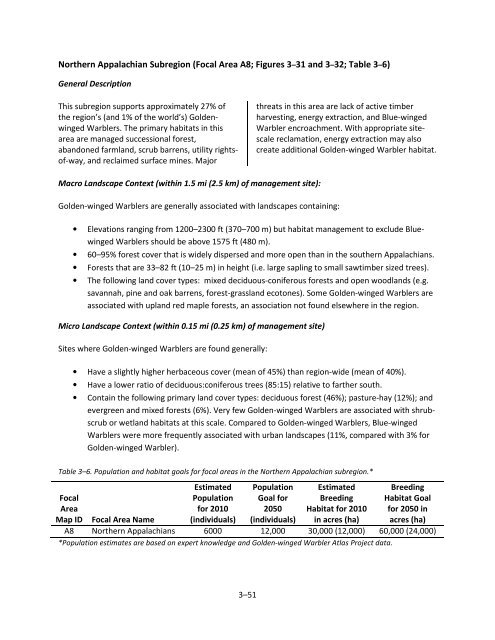Review and download Chapter 3 - Golden-winged Warbler Working ...
Review and download Chapter 3 - Golden-winged Warbler Working ...
Review and download Chapter 3 - Golden-winged Warbler Working ...
You also want an ePaper? Increase the reach of your titles
YUMPU automatically turns print PDFs into web optimized ePapers that Google loves.
Northern Appalachian Subregion (Focal Area A8; Figures 3–31 <strong>and</strong> 3–32; Table 3–6)<br />
General Description<br />
This subregion supports approximately 27% of<br />
the region’s (<strong>and</strong> 1% of the world’s) <strong>Golden</strong><strong>winged</strong><br />
<strong>Warbler</strong>s. The primary habitats in this<br />
area are managed successional forest,<br />
ab<strong>and</strong>oned farml<strong>and</strong>, scrub barrens, utility rightsof-way,<br />
<strong>and</strong> reclaimed surface mines. Major<br />
Macro L<strong>and</strong>scape Context (within 1.5 mi (2.5 km) of management site):<br />
<strong>Golden</strong>-<strong>winged</strong> <strong>Warbler</strong>s are generally associated with l<strong>and</strong>scapes containing:<br />
3–51<br />
threats in this area are lack of active timber<br />
harvesting, energy extraction, <strong>and</strong> Blue-<strong>winged</strong><br />
<strong>Warbler</strong> encroachment. With appropriate sitescale<br />
reclamation, energy extraction may also<br />
create additional <strong>Golden</strong>-<strong>winged</strong> <strong>Warbler</strong> habitat.<br />
• Elevations ranging from 1200–2300 ft (370–700 m) but habitat management to exclude Blue<strong>winged</strong><br />
<strong>Warbler</strong>s should be above 1575 ft (480 m).<br />
• 60–95% forest cover that is widely dispersed <strong>and</strong> more open than in the southern Appalachians.<br />
• Forests that are 33–82 ft (10–25 m) in height (i.e. large sapling to small sawtimber sized trees).<br />
• The following l<strong>and</strong> cover types: mixed deciduous-coniferous forests <strong>and</strong> open woodl<strong>and</strong>s (e.g.<br />
savannah, pine <strong>and</strong> oak barrens, forest-grassl<strong>and</strong> ecotones). Some <strong>Golden</strong>-<strong>winged</strong> <strong>Warbler</strong>s are<br />
associated with upl<strong>and</strong> red maple forests, an association not found elsewhere in the region.<br />
Micro L<strong>and</strong>scape Context (within 0.15 mi (0.25 km) of management site)<br />
Sites where <strong>Golden</strong>-<strong>winged</strong> <strong>Warbler</strong>s are found generally:<br />
• Have a slightly higher herbaceous cover (mean of 45%) than region-wide (mean of 40%).<br />
• Have a lower ratio of deciduous:coniferous trees (85:15) relative to farther south.<br />
• Contain the following primary l<strong>and</strong> cover types: deciduous forest (46%); pasture-hay (12%); <strong>and</strong><br />
evergreen <strong>and</strong> mixed forests (6%). Very few <strong>Golden</strong>-<strong>winged</strong> <strong>Warbler</strong>s are associated with shrubscrub<br />
or wetl<strong>and</strong> habitats at this scale. Compared to <strong>Golden</strong>-<strong>winged</strong> <strong>Warbler</strong>s, Blue-<strong>winged</strong><br />
<strong>Warbler</strong>s were more frequently associated with urban l<strong>and</strong>scapes (11%, compared with 3% for<br />
<strong>Golden</strong>-<strong>winged</strong> <strong>Warbler</strong>).<br />
Table 3–6. Population <strong>and</strong> habitat goals for focal areas in the Northern Appalachian subregion.*<br />
Focal<br />
Area<br />
Map ID Focal Area Name<br />
Estimated<br />
Population<br />
for 2010<br />
(individuals)<br />
Population<br />
Goal for<br />
2050<br />
(individuals)<br />
Estimated<br />
Breeding<br />
Habitat for 2010<br />
in acres (ha)<br />
Breeding<br />
Habitat Goal<br />
for 2050 in<br />
acres (ha)<br />
A8 Northern Appalachians 6000 12,000 30,000 (12,000) 60,000 (24,000)<br />
*Population estimates are based on expert knowledge <strong>and</strong> <strong>Golden</strong>-<strong>winged</strong> <strong>Warbler</strong> Atlas Project data.


